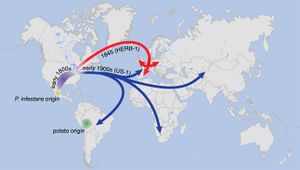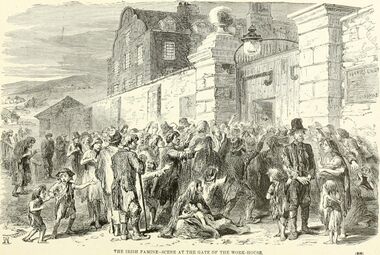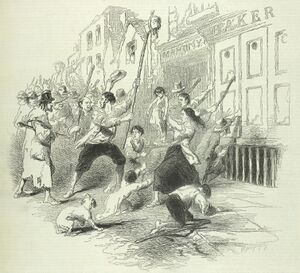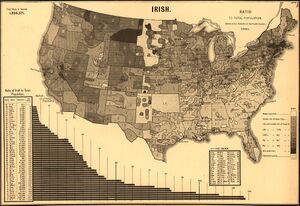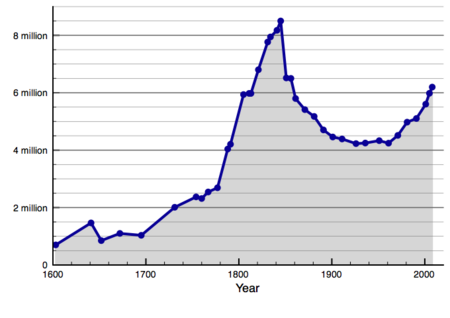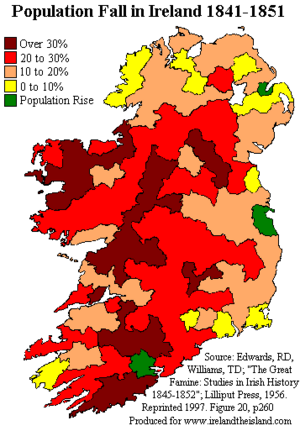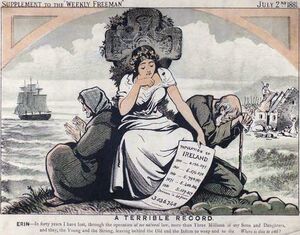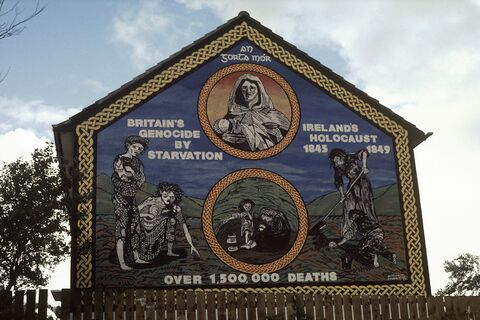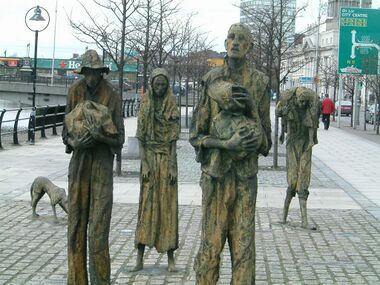مجاعة أيرلندا الكبرى
| مجاعة أيرلندا الكبرى An Gorta Mór | |
|---|---|
 Scene at Skibbereen during the Great Famine by Cork artist James Mahony, The Illustrated London News, 1847 | |
| الموقع | Ireland |
| الفترة | 1845–1852 |
| إجمالي الوفيات | 1 million |
| الأسباب | Policy failure, potato blight |
| النظرية | Corn Laws, Gregory clause, Encumbered Estates' Court, Crime and Outrage Bill (Ireland) 1847, Young Irelander Rebellion of 1848, Three Fs, Poor Law Amendment Act |
| الإنقاذ | See below |
| التأثير الديموغرافي | Population fell by 20–25% due to death and emigration |
| التبعات | Permanent change in the country's demographic, political, and cultural landscape |
| الموقع الإلكتروني | See list of memorials to the Great Famine |
| سبقها | Irish Famine (1740–1741) (Bliain an Áir) |
| تبعها | Irish Famine, 1879 (An Gorta Beag) |
The Great Famine, also known as the Great Hunger (أيرلندية: an Gorta Mór [ənˠ ˈɡɔɾˠt̪ˠə ˈmˠoːɾˠ]), the Famine and the Irish Potato Famine,[1][2] was a period of starvation and disease in Ireland lasting from 1845 to 1852 that constituted a historical social crisis and subsequently had a major impact on Irish society and history as a whole.[3] The most severely affected areas were in the western and southern parts of Ireland — where the Irish language was dominant — and hence the period was contemporaneously known in Irish as an Drochshaol,[4] which literally translates to "the bad life" and loosely translates to "the hard times". The worst year of the famine was 1847, which became known as "Black '47".[5][6] During the Great Hunger, roughly 1 million people died and more than 1 million more fled the country,[7] causing the country's population to fall by 20–25% (in some towns, populations fell as much as 67%) between 1841 and 1871.[8][9][10] Between 1845 and 1855, at least 2.1 million people left Ireland, primarily on packet ships but also on steamboats and barques—one of the greatest exoduses from a single island in history.[11][12]
The proximate cause of the famine was the infection of potato crops by blight (Phytophthora infestans)[13] throughout Europe during the 1840s. Blight infection caused 100,000 deaths outside Ireland and influenced much of the unrest that culminated in European Revolutions of 1848.[14] Longer-term reasons for the massive impact of this particular famine included the system of absentee landlordism[[#cite_note-FOOTNOTELaxton1997[[تصنيف:مقالات_بالمعرفة_بحاجة_لذكر_رقم_الصفحة_بالمصدر_from_September_2018]][[Category:Articles_with_invalid_date_parameter_in_template]]<sup_class="noprint_Inline-Template_"_style="white-space:nowrap;">[<i>[[المعرفة:Citing_sources|<span_title="هذه_المقولة_تحتاج_مرجع_إلى_صفحة_محددة_أو_نطاق_من_الصفحات_تظهر_فيه_المقولة'"`UNIQ--nowiki-00000010-QINU`"'_(September_2018)">صفحة مطلوبة</span>]]</i>]</sup>-15|[15]]][[#cite_note-FOOTNOTELitton1994[[تصنيف:مقالات_بالمعرفة_بحاجة_لذكر_رقم_الصفحة_بالمصدر_from_September_2018]][[Category:Articles_with_invalid_date_parameter_in_template]]<sup_class="noprint_Inline-Template_"_style="white-space:nowrap;">[<i>[[المعرفة:Citing_sources|<span_title="هذه_المقولة_تحتاج_مرجع_إلى_صفحة_محددة_أو_نطاق_من_الصفحات_تظهر_فيه_المقولة'"`UNIQ--nowiki-00000012-QINU`"'_(September_2018)">صفحة مطلوبة</span>]]</i>]</sup>-16|[16]]] and single-crop dependence.[17][18] Initial limited but constructive government actions to alleviate famine distress were ended by a new Whig administration in London, which pursued a laissez-faire economic doctrine, but also because some in power believed in divine providence or that the Irish lacked moral character,[19][20] with aid only resuming to some degree later. Large amounts of food were exported from Ireland during the famine and the refusal of London to bar such exports, as had been done on previous occasions, was an immediate and continuing source of controversy, contributing to anti-British sentiment and the campaign for independence. Additionally, the famine indirectly resulted in tens of thousands of households being evicted, exacerbated by a provision forbidding access to workhouse aid while in possession of more than one-quarter acre of land.
The famine was a defining moment in the history of Ireland,[3] which was part of the United Kingdom of Great Britain and Ireland from 1801 to 1922. The famine and its effects permanently changed the island's demographic, political, and cultural landscape, producing an estimated 2 million refugees and spurring a century-long population decline.[21][22][23][24] For both the native Irish and those in the resulting diaspora, the famine entered folk memory.[25] The strained relations between many Irish and their ruling British government worsened further because of the famine, heightening ethnic and sectarian tensions and boosting nationalism and republicanism both in Ireland and among Irish emigrants around the world. English documentary maker John Percival said that the famine "became part of the long story of betrayal and exploitation which led to the growing movement in Ireland for independence." Scholar Kirby Miller makes the same point.[26][27] Debate exists regarding nomenclature for the event, whether to use the term "Famine", "Potato Famine" or "Great Hunger", the last of which some believe most accurately captures the complicated history of the period.[28]
The potato blight returned to Europe in 1879 but, by this time, the Land War (one of the largest agrarian movements to take place in 19th-century Europe) had begun in Ireland.[29] The movement, organized by the Land League, continued the political campaign for the Three Fs which was issued in 1850 by the Tenant Right League during the Great Famine. When the potato blight returned to Ireland in the 1879 famine, the League boycotted "notorious landlords" and its members physically blocked the evictions of farmers; the consequent reduction in homelessness and house demolition resulted in a drastic reduction in the number of deaths.[30]
. . . . . . . . . . . . . . . . . . . . . . . . . . . . . . . . . . . . . . . . . . . . . . . . . . . . . . . . . . . . . . . . . . . . . . . . . . . . . . . . . . . . . . . . . . . . . . . . . . . . . . . . . . . . . . . . . . . . . . . . . . . . . . . . . . . . . . . . . . . . . . . . . . . . . . . . . . . . . . . . . . . . . . . .
Causes and contributing factors
Ireland was brought into the United Kingdom in January 1801 following the passage of the Acts of Union. Executive power lay in the hands of the Lord Lieutenant of Ireland and Chief Secretary for Ireland, who were appointed by the British government. Ireland sent 105 members of parliament to the House of Commons of the United Kingdom, and Irish representative peers elected 28 of their own number to sit for life in the House of Lords. Between 1832 and 1859, 70% of Irish representatives were landowners or the sons of landowners.[[#cite_note-FOOTNOTEPóirtéir1995[[تصنيف:مقالات_بالمعرفة_بحاجة_لذكر_رقم_الصفحة_بالمصدر_from_September_2018]][[Category:Articles_with_invalid_date_parameter_in_template]]<sup_class="noprint_Inline-Template_"_style="white-space:nowrap;">[<i>[[المعرفة:Citing_sources|<span_title="هذه_المقولة_تحتاج_مرجع_إلى_صفحة_محددة_أو_نطاق_من_الصفحات_تظهر_فيه_المقولة'"`UNIQ--nowiki-00000025-QINU`"'_(September_2018)">صفحة مطلوبة</span>]]</i>]</sup>-31|[31]]]
In the 40 years that followed the union, successive British governments grappled with the problems of governing a country which had, as Benjamin Disraeli stated in 1844, "a starving population, an absentee aristocracy, an alien established Protestant church, and in addition, the weakest executive in the world".[32] One historian calculated that, between 1801 and 1845, there had been 114 commissions and 61 special committees inquiring into the state of Ireland, and that "without exception their findings prophesied disaster; Ireland was on the verge of starvation, her population rapidly increasing, three-quarters of her labourers unemployed, housing conditions appalling and the standard of living unbelievably low".[33]
Lectures printed in 1847 by John Hughes, Bishop of New York, are a contemporary exploration into the antecedent causes, particularly the political climate, in which the Irish famine occurred.[34][35]
Landlords and tenants
The "middleman system" for managing landed property was introduced in the 18th century. Rent collection was left in the hands of the landlords' agents, or middlemen. This assured the landlord of a regular income and relieved them of direct responsibility while leaving tenants open to exploitation by the middlemen.[36] The ability of middlemen was measured by the rent income they could contrive to extract from tenants.[36] Middlemen leased large tracts of land from the landlords on long leases with fixed rents and sublet to tenants, keeping any money raised in excess to the rent paid to the landlord. This system, coupled with minimal oversight of the middlemen, incentivised harsh exploitation of tenants. Middlemen would split a holding into smaller and smaller parcels so as to increase the amount of rent they could obtain. Tenants could be evicted for reasons such as non-payment of rents (which were high), or a landlord's decision to raise sheep instead of grain crops. Cottiers paid their rent by working for the landlord while the spalpeens (itinerant labourers) paid for short-term leases through temporary day work.[37][38]
A majority of Catholics, who constituted 80% of the Irish population, lived in conditions of poverty and insecurity. At the top of the social hierarchy was the Ascendancy class, composed of English and Anglo-Irish families who owned most of the land and held more or less unchecked power over their tenants. Some of their estates were vast; for example, the Earl of Lucan owned more than 60,000 acres (240 km2). Many of these landowners lived in England and functioned as absentee landlords. The rent revenue—collected from impoverished tenants who were paid minimal wages to raise crops and livestock for export[[#cite_note-FOOTNOTELaxton1997[[تصنيف:مقالات_بالمعرفة_بحاجة_لذكر_رقم_الصفحة_بالمصدر_from_September_2018]][[Category:Articles_with_invalid_date_parameter_in_template]]<sup_class="noprint_Inline-Template_"_style="white-space:nowrap;">[<i>[[المعرفة:Citing_sources|<span_title="هذه_المقولة_تحتاج_مرجع_إلى_صفحة_محددة_أو_نطاق_من_الصفحات_تظهر_فيه_المقولة'"`UNIQ--nowiki-0000002F-QINU`"'_(September_2018)">صفحة مطلوبة</span>]]</i>]</sup>-39|[39]]]—was mostly sent to England.[[#cite_note-FOOTNOTELitton1994[[تصنيف:مقالات_بالمعرفة_بحاجة_لذكر_رقم_الصفحة_بالمصدر_from_September_2018]][[Category:Articles_with_invalid_date_parameter_in_template]]<sup_class="noprint_Inline-Template_"_style="white-space:nowrap;">[<i>[[المعرفة:Citing_sources|<span_title="هذه_المقولة_تحتاج_مرجع_إلى_صفحة_محددة_أو_نطاق_من_الصفحات_تظهر_فيه_المقولة'"`UNIQ--nowiki-00000031-QINU`"'_(September_2018)">صفحة مطلوبة</span>]]</i>]</sup>-40|[40]]]
In 1800, the 1st Earl of Clare observed of landlords that "confiscation is their common title".[41][42] According to the historian Cecil Woodham-Smith, landlords regarded the land as a source of income, from which as much as possible was to be extracted. With the peasantry "brooding over their discontent in sullen indignation" (in the words of the Earl of Clare), the landlords largely viewed the countryside as a hostile place in which to live. Some landlords visited their property only once or twice in a lifetime, if ever.[41] The rents from Ireland were generally spent elsewhere; an estimated £6,000,000 was remitted out of Ireland in 1842.[41][أ]
In 1843, the British Government recognized that the land management system in Ireland was the foundational cause of disaffection in the country. The Prime Minister established a Royal Commission, chaired by the Earl of Devon (Devon Commission), to enquire into the laws regarding the occupation of land. Irish politician Daniel O'Connell described this commission as "perfectly one-sided", being composed of landlords with no tenant representation.[43]
In February 1845, Devon reported:
It would be impossible adequately to describe the privations which they [the Irish labourer and his family] habitually and silently endure ... in many districts their only food is the potato, their only beverage water ... their cabins are seldom a protection against the weather ... a bed or a blanket is a rare luxury ... and nearly in all their pig and a manure heap constitute their only property.[44]
The Commissioners concluded they could not "forbear expressing our strong sense of the patient endurance which the labouring classes have exhibited under sufferings greater, we believe, than the people of any other country in Europe have to sustain".[44] The Commission stated that bad relations between landlord and tenant were principally responsible for this suffering. Landlords were described in evidence before the commission as "land sharks", "bloodsuckers", and "the most oppressive species of tyrant that ever lent assistance to the destruction of a country".[36]
As any improvement made on a holding by a tenant became the property of the landlord when the lease expired or was terminated, the incentive to make improvements was limited. Most tenants had no security of tenure on the land; as tenants "at will", they could be turned out whenever the landlord chose. The only exception to this arrangement was in Ulster where, under a practice known as "tenant right", a tenant was compensated for any improvement they made to their holding. According to Woodham-Smith, the commission stated that "the superior prosperity and tranquillity of Ulster, compared with the rest of Ireland, were due to tenant right".[36]
Landlords in Ireland often used their powers without compunction, and tenants lived in dread of them. Woodham-Smith writes that, in these circumstances, "industry and enterprise were extinguished and a peasantry created which was one of the most destitute in Europe".[44]
Tenants and subdivisions
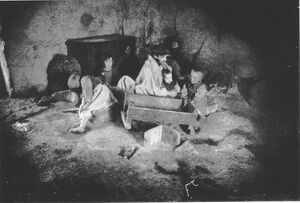
Immense population growth, from about 2 million in 1700 to 8 million by the time of the Great Famine, led to increased division of holdings and a consequent reduction in their average size. By 1845, 24% of all Irish tenant farms were of 0.4–2 hectares (1–5 acres) in size, while 40% were of 2–6 hectares (5–15 acres). Holdings were so small that no crop other than potatoes would suffice to feed a family. Shortly before the famine, the British government reported that poverty was so widespread that one-third of all Irish small holdings could not support the tenant families after rent was paid; the families survived only by earnings as seasonal migrant labour in England and Scotland.[45] Following the famine, reforms were implemented making it illegal to further divide land holdings.[46]
The 1841 census showed a population of just over eight million. Two-thirds of people depended on agriculture for their survival but rarely received a working wage. They had to work for their landlords in return for a small patch of land to farm. This forced Ireland's peasantry to practice continuous monoculture, as the potato was the only crop that could meet nutritional needs.[[#cite_note-FOOTNOTELaxton1997[[تصنيف:مقالات_بالمعرفة_بحاجة_لذكر_رقم_الصفحة_بالمصدر_from_September_2018]][[Category:Articles_with_invalid_date_parameter_in_template]]<sup_class="noprint_Inline-Template_"_style="white-space:nowrap;">[<i>[[المعرفة:Citing_sources|<span_title="هذه_المقولة_تحتاج_مرجع_إلى_صفحة_محددة_أو_نطاق_من_الصفحات_تظهر_فيه_المقولة'"`UNIQ--nowiki-00000041-QINU`"'_(September_2018)">صفحة مطلوبة</span>]]</i>]</sup>-48|[47]]]
Potato dependency

The potato was introduced in Ireland as a garden crop of the gentry. By the late 17th century, it had become widespread as a supplementary food; their main diet was still based on butter, milk, and grain products.[17]
The Irish economy grew between 1760 and 1815 due to infrastructure expansion and the Napoleonic Wars (1805–1815), which had increased the demand for food in Britain. Tillage increased to such an extent that there was only a small amount of land available to small farmers to feed themselves. The potato was adopted as a primary food source because of its quick growth in a comparatively small space.[48] By 1800, the potato had become a staple food for one in three Irish people,[48] especially in winter. It eventually became a staple year-round for farmers.[49] A disproportionate share of the potatoes grown in Ireland were the Irish Lumper,[18] creating a lack of genetic variability among potato plants, which increased vulnerability to disease.[50]
Potatoes were essential to the expansion of the cottier system; they supported an extremely cheap workforce, but at the cost of lower living standards. For the labourer, "a potato wage" shaped the expanding agrarian economy.[49] The potato was also used extensively as a fodder crop for livestock immediately prior to the famine. Approximately 33% of production, amounting to 5,000,000 short tons (4,500,000 t), was typically used in this way.[51]
Blight in Ireland
Prior to the arrival of Phytophthora infestans, commonly known as "blight", only two main potato plant diseases had been discovered.[52] One was called "dry rot" or "taint", and the other was a virus known popularly as "curl".[52][53] Phytophthora infestans is an oomycete (a variety of parasitic, non-photosynthetic organisms closely related to brown algae, and not a fungus).[54]
In 1851, the Census of Ireland Commissioners recorded 24 failures of the potato crop going back to 1728, of varying severity. General crop failures, through disease or frost, were recorded in 1739, 1740, 1770, 1800, and 1807. In 1821 and 1822, the potato crop failed in Munster and Connaught. In 1830 and 1831, counties Mayo, Donegal, and Galway suffered likewise. In 1832, 1833, 1834, and 1836, dry rot and curl caused serious losses, and in 1835 the potato failed in Ulster. Widespread failures throughout Ireland occurred in 1836, 1837, 1839, 1841, and 1844. According to Woodham-Smith, "the unreliability of the potato was an accepted fact in Ireland".[55]
Experts are still unsure of how and when blight arrived in Europe; it almost certainly was not present prior to 1842, and probably arrived in 1844.[56] The origin of the pathogen has been traced to the Toluca Valley in Mexico,[57][58] whence it spread within North America and then to Europe.[56] The 1845–1846 blight was caused by the HERB-1 strain of the blight.[59][60]
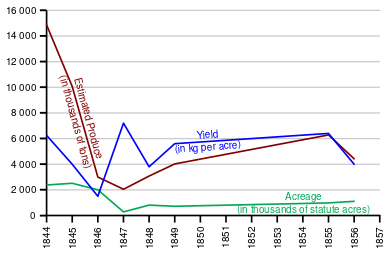
In 1844, Irish newspapers carried reports concerning a disease that had attacked the potato crops in America for two years.[62] In 1843 and 1844, blight largely destroyed the potato crops in the Eastern United States. Ships from Baltimore, Philadelphia, or New York City could have carried diseased potatoes from these areas to European ports.[63] American plant pathologist William C. Paddock[64] posited that the blight was transported via potatoes being carried to feed passengers on clipper ships sailing from America to Ireland.[54] Once introduced in Ireland and Europe, blight spread rapidly. By mid-August 1845, it had reached much of northern and central Europe; Belgium, The Netherlands, northern France, and southern England had all already been affected.[65]
On 16 August 1845, The Gardeners' Chronicle and Horticultural Gazette reported "a blight of unusual character" on the Isle of Wight. A week later, on 23 August, it reported that "A fearful malady has broken out among the potato crop ... In Belgium the fields are said to be completely desolated. There is hardly a sound sample in Covent Garden market ... As for cure for this distemper, there is none."[66] These reports were extensively covered in Irish newspapers.[67] On 11 September, the Freeman's Journal reported on "the appearance of what is called 'cholera' in potatoes in Ireland, especially in the north".[68] On 13 September,[fn 1] The Gardeners' Chronicle announced: "We stop the Press with very great regret to announce that the potato Murrain has unequivocally declared itself in Ireland."[66]
Nevertheless, the British government remained optimistic over the next few weeks, as it received conflicting reports. Only when the crop was harvested in October did the scale of destruction become apparent.[69] Prime Minister Sir Robert Peel wrote to Sir James Graham in mid-October that he found the reports "very alarming", but allayed his fears by claiming that there was "always a tendency to exaggeration in Irish news".[70]
Crop loss in 1845 has been estimated at anywhere from one-third[13] to one-half of cultivated acreage.[67] The Mansion House Committee in Dublin, to which hundreds of letters were directed from all over Ireland, claimed on 19 November 1845 to have ascertained beyond the shadow of a doubt that "considerably more than one-third of the entire of the potato crop ... has been already destroyed".[65]
In 1846, three-quarters of the harvest was lost to blight.[71] By December, a third of a million destitute people were employed in public works.[72] According to Cormac Ó Gráda, the first attack of potato blight caused considerable hardship in rural Ireland from the autumn of 1846, when the first deaths from starvation were recorded.[73] Seed potatoes were scarce in 1847. Few had been sown, so, despite average yields, hunger continued. 1848 yields were only two-thirds of normal. Since over three million Irish people were totally dependent on potatoes for food, hunger and famine were widespread.[71]
. . . . . . . . . . . . . . . . . . . . . . . . . . . . . . . . . . . . . . . . . . . . . . . . . . . . . . . . . . . . . . . . . . . . . . . . . . . . . . . . . . . . . . . . . . . . . . . . . . . . . . . . . . . . . . . . . . . . . . . . . . . . . . . . . . . . . . . . . . . . . . . . . . . . . . . . . . . . . . . . . . . . . . . .
Reaction in Ireland
The Corporation of Dublin sent a memorial to the Queen, "praying her" to call Parliament together early (Parliament was at this time prorogued), and to recommend the requisition of some public money for public works, especially railways in Ireland. The Town Council of Belfast met and made similar suggestions, but neither body asked for charity, according to John Mitchel, one of the leading Repealers.[بحاجة لمصدر]
In early November 1845, a deputation from the citizens of Dublin, including the Duke of Leinster, Lord Cloncurry, Daniel O'Connell and the Lord Mayor, went to the Lord Lieutenant of Ireland, Lord Heytesbury to discuss the issue. They offered suggestions such as opening the ports to foreign corn, stopping distillation from grain, prohibiting the export of foodstuffs, and providing employment through public works.[74] Lord Heytesbury urged them not to be alarmed, that they "were premature", that scientists were enquiring into all those matters,[fn 2] and that the Inspectors of Constabulary and Stipendiary Magistrates were charged with making constant reports from their districts, and there was no "immediate pressure on the market".[76][مطلوب مصدر أفضل]
On 8 December 1845, Daniel O'Connell, head of the Repeal Association, proposed several remedies to the pending disaster. One of the first things he suggested was the introduction of Tenant-Right as practised in Ulster, giving the landlord a fair rent for his land, but giving the tenant compensation for any money he might have laid out on the land in permanent improvements.[77][مطلوب مصدر أفضل] O'Connell noted actions taken by the Belgian legislature during the same season, as they had also been hit by blight: shutting their ports against the export of provisions and opening them to imports. He suggested that, if Ireland had a domestic Parliament, the ports would be thrown open and the abundant crops raised in Ireland would be kept for the people of Ireland, as the Dublin parliament had done during the food shortages of the 1780s. O'Connell maintained that only an Irish parliament would provide both food and employment for the people. He said that repeal of the Act of Union was a necessity and Ireland's only hope.[77][مطلوب مصدر أفضل]
Mitchel later wrote one of the first widely circulated tracts on the famine, The Last Conquest of Ireland (Perhaps), published in 1861. It proposed that British actions during the famine and their treatment of the Irish were a deliberate effort at genocide. It contained a sentence that has since become famous: "The Almighty, indeed, sent the potato blight, but the English created the Famine."[78] Mitchel was charged with sedition because of his writings, but this charge was dropped. He was convicted by a packed jury under the newly enacted Treason Felony Act and sentenced to 14 years transportation to Bermuda.[79]
According to Charles Gavan Duffy, The Nation insisted that the proper remedy, retaining in the country the food raised by her people until the people were fed,[80] was one which the rest of Europe had adopted, and one which even the parliaments of the Pale (i.e., before the union with Great Britain in 1801) had adopted in periods of distress.
Contemporaneously, as found in letters from the period and in particular later oral memory, the name for the event is in أيرلندية: An Drochshaol, though with the earlier spelling standard of the era, which was Gaelic script, it is found written as in Droċ-Ṡaoġal.[81][82] In the modern era, this name, while loosely translated as "the hard-time", is always denoted with a capital letter to express its specific historic meaning.[83][5][84][85][86]
The period of the potato blight in Ireland from 1845 to 1851 was full of political confrontation.[[#cite_note-FOOTNOTEPóirtéir1995[[تصنيف:مقالات_بالمعرفة_بحاجة_لذكر_رقم_الصفحة_بالمصدر_from_September_2023]][[Category:Articles_with_invalid_date_parameter_in_template]]<sup_class="noprint_Inline-Template_"_style="white-space:nowrap;">[<i>[[المعرفة:Citing_sources|<span_title="هذه_المقولة_تحتاج_مرجع_إلى_صفحة_محددة_أو_نطاق_من_الصفحات_تظهر_فيه_المقولة'"`UNIQ--nowiki-0000007F-QINU`"'_(September_2023)">صفحة مطلوبة</span>]]</i>]</sup>-90|[87]]] A more radical Young Ireland group seceded from the Repeal movement in July 1846, and attempted an armed rebellion in 1848. It was unsuccessful.[88]
In 1847, William Smith O'Brien, leader of the Young Ireland party, became one of the founding members of the Irish Confederation[[#cite_note-FOOTNOTEDoheny1951[[تصنيف:مقالات_بالمعرفة_بحاجة_لذكر_رقم_الصفحة_بالمصدر_from_September_2023]][[Category:Articles_with_invalid_date_parameter_in_template]]<sup_class="noprint_Inline-Template_"_style="white-space:nowrap;">[<i>[[المعرفة:Citing_sources|<span_title="هذه_المقولة_تحتاج_مرجع_إلى_صفحة_محددة_أو_نطاق_من_الصفحات_تظهر_فيه_المقولة'"`UNIQ--nowiki-00000082-QINU`"'_(September_2023)">صفحة مطلوبة</span>]]</i>]</sup>-92|[89]]] to campaign for a Repeal of the Act of Union, and called for the export of grain to be stopped and the ports closed.[90][مطلوب مصدر أفضل] The following year, he helped organise the short-lived Young Irelander Rebellion of 1848 in County Tipperary.[91]
Government response
Government responses to previous food shortages
When Ireland experienced food shortages in 1782–1783, ports were closed to exporting food, with the intention of keeping locally grown food in Ireland to feed the hungry. Irish food prices promptly dropped. Some merchants lobbied against the export ban, but the government in the 1780s overrode their protests.[92][93]
Tory government
Historian F. S. L. Lyons characterised the initial response of the British government to the early, less severe phase of the famine as "prompt and relatively successful".[94] Confronted by widespread crop failure in November 1845, the Prime Minister, Sir Robert Peel, purchased £100,000 worth of maize and cornmeal secretly from America[95] with Baring Brothers initially acting as his agents. The government hoped that they would not "stifle private enterprise" and that their actions would not act as a disincentive to local relief efforts. Due to poor weather conditions, the first shipment did not arrive in Ireland until the beginning of February 1846.[96] The initial shipments were of unground dried kernels, but the few Irish mills in operation were not equipped for milling maize and a long and complicated milling process had to be adopted before the meal could be distributed.[97] In addition, before the cornmeal could be consumed, it had to be "very much" cooked again, or eating it could result in severe bowel complaints.[96] Due to its yellow colour, and initial unpopularity, it became known as "Peel's brimstone".[98]
In October 1845, Peel moved to repeal the Corn Laws—tariffs on grain which kept the price of bread high—but the issue split his party and he had insufficient support from his own colleagues to push the measure through. He resigned the premiership in December, but the opposition was unable to form a government and he was re-appointed.[99] In March, Peel set up a programme of public works in Ireland,[100] but the famine situation worsened during 1846, and the repeal of the Corn Laws in that year did little to help the starving Irish; the measure split the Conservative Party, leading to the fall of Peel's ministry.[101] On 25 June, the second reading of the government's Irish Coercion Bill was defeated by 73 votes in the House of Commons by a combination of Whigs, Radicals, Irish Repealers, and protectionist Conservatives. Peel was forced to resign as prime minister on 29 June, and the Whig leader, Lord John Russell, became prime minister.[102]
Whig government
The measures undertaken by Peel's successor, Russell, proved inadequate as the crisis deepened. The new Whig administration, influenced by the doctrine of laissez-faire,[103] believed that the market would provide the food needed. They refused to interfere with the movement of food to England, and then halted the previous government's food and relief works, leaving many hundreds of thousands of people without access to work, money, or food.[104] Russell's ministry introduced a new programme of public works that by the end of December 1846 employed some half a million but proved impossible to administer.[105]

Charles Trevelyan, who was in charge of the administration of government relief, limited the Government's food aid programme, claiming that food would be readily imported into Ireland once people had more money to spend after wages were being paid on new public-works projects.[106] Saying "The judgement of God send the calamity to teach the Irish a lesson and that calamity must not be too mitigated [..] The real evil with which we have to contend is not the physical evil of the famine, but the moral evil of the selfish, perverse and turbulent character of the people."[107][108]
In a private correspondence, Trevelyan explained how the famine could bring benefit to the English; As he wrote to Edward Twisleton:
"We must not complain of what we really want to obtain. If small farmers go, and their landlords are reduced to sell portions of their estates to persons who will invest capital we shall at last arrive at something like a satisfactory settlement of the country".[107]
In January 1847, the government abandoned its policy of noninterference, realising that it had failed, and turned to a mixture of "indoor" and "outdoor" direct relief; the former administered in workhouses through the Irish Poor Laws, the latter through soup kitchens. The costs of the Poor Law fell primarily on the local landlords, some of whom in turn attempted to reduce their liability by evicting their tenants [105] or providing some relief through the conversionist practice of Souperism.
On 1 March 1847, the Bank of England announced plans to raise a loan of £14 million to relieve the Irish crisis, and also for unfunded tax cuts. This led to the Panic of 1847, in which gold was withdrawn from circulation, so reducing the amount of bank notes that the Bank could legally circulate.[109] By 17 April 1847 the bullion reserve of the Bank of England had diminished from £15 million in January to some £9 million, and it was announced that the cost of famine relief would be transferred to local taxes in Ireland. The financial crisis temporarily improved, but the intended relief for Ireland did not materialise.[110]
In June 1847, the Poor Law Amendment Act was passed which embodied the principle, popular in Britain, that Irish property must support Irish poverty. The landed proprietors in Ireland were held in Britain to have created the conditions that led to the famine.[111][112] However, it was asserted that the British parliament since the Act of Union of 1800 was partly to blame.[111] This point was raised in The Illustrated London News on 13 February 1847: "There was no law it would not pass at their request, and no abuse it would not defend for them." On 24 March, The Times reported that Britain had permitted in Ireland "a mass of poverty, disaffection, and degradation without a parallel in the world. It allowed proprietors to suck the very life-blood of that wretched race".[111]
The "Gregory clause" of the Poor Law, named after William H. Gregory, M.P.[fn 3], prohibited anyone who held at least 1⁄4 acre (0.1 ha) from receiving relief.[105] In practice, this meant that the many farmers who had to sell all their produce to pay rent and taxes, would have to deliver up all their land to the landlord to qualify for public outdoor relief. Of this Law, Mitchel wrote that "it is the able-bodied idler only who is to be fed—if he attempted to till but one rood of ground, he dies". This simple method of ejectment was called "passing paupers through the workhouse"—a man went in, a pauper came out.[114][مطلوب مصدر أفضل] These factors combined to drive thousands of people off the land: 90,000 in 1849, and 104,000 in 1850.[105]
In 1849, the Encumbered Estates Act allowed landlord estates to be auctioned off upon the petition of creditors. Estates with debts were then auctioned off at low prices. Wealthy British speculators purchased the lands and "took a harsh view" of the tenant farmers who continued renting. The rents were raised, and tenants evicted to create large cattle grazing pastures. Between 1849 and 1854, some 50,000 families were evicted.[115][116]
. . . . . . . . . . . . . . . . . . . . . . . . . . . . . . . . . . . . . . . . . . . . . . . . . . . . . . . . . . . . . . . . . . . . . . . . . . . . . . . . . . . . . . . . . . . . . . . . . . . . . . . . . . . . . . . . . . . . . . . . . . . . . . . . . . . . . . . . . . . . . . . . . . . . . . . . . . . . . . . . . . . . . . . .
Military response
The Royal Navy squadron stationed in Cork under the command of Rear-Admiral Hugh Pigot undertook significant relief operations from 1846 to 1847, transporting government relief into the port of Cork and other ports along the Irish coast, being ordered on 2 January 1846 to assist distressed regions. On 27 December 1846, Trevelyan ordered every available steamship to Ireland to assist in relief, and on 14 January 1847, Pigot received orders to also distribute supplies from the British Relief Association and treat them identically to government aid. In addition, some naval officers under Pigot oversaw the logistics of relief operations further inland from Cork. In February 1847, Trevelyan ordered Royal Navy surgeons dispatched to provide medical care for those suffering from illnesses that accompanied starvation, distribute medicines that were in short supply, and assist in proper, sanitary burials for the deceased. These efforts, although significant, were insufficient at preventing mass mortality from famine and disease.[117]
Food exports
| Year | Exports | Imports | Surplus | Maize Imports |
|---|---|---|---|---|
| 1842 | 2,538 | 280 | +2,258 | 20 |
| 1843 | 3,206 | 74 | +3,132 | 3 |
| 1844 | 2,801 | 150 | +2,651 | 5 |
| 1845 | 3,252 | 147 | +3,105 | 34 |
| 1846 | 1,826 | 987 | +839 | 614 |
| 1847 | 970 | 4,519 | -3,549 | 3,287 |
| 1848 | 1,953 | 2,186 | -233 | 1,546 |
| 1849 | 1,437 | 2,908 | -1,471 | 1,897 |
| 1850 | 1,329 | 2,357 | -1,028 | 1,159 |
| 1851 | 1,325 | 3,158 | -1,833 | 1,745 |
The historian Cecil Woodham-Smith wrote in The Great Hunger: Ireland 1845–1849 that no issue has provoked so much anger and embittered relations between England and Ireland "as the indisputable fact that huge quantities of food were exported from Ireland to England throughout the period when the people of Ireland were dying of starvation".[119] While in addition to the maize imports, four times as much wheat was imported into Ireland at the height of the famine as exported.[120][121] Woodham-Smith added that provision via the Poor law union workhouses by the Act of 1838 had to be paid by rates levied on the local property owners, and in areas where the famine was worst, the tenants could not pay their rents to enable landlords to fund the rates and therefore the workhouses. Only by selling food, some of which would inevitably be exported, could a "virtuous circle" be created whereby the rents and rates would be paid, and the workhouses funded. Relief through the workhouse system was simply overwhelmed by the enormous scale and duration of the famine.[122] Nicolas McEvoy, parish priest of Kells, wrote in October 1845:
On my most minute personal inspection of the potato crop in this most fertile potato-growing locale is founded my inexpressibly painful conviction that one family in twenty of the people will not have a single potato left on Christmas day next. Many are the fields I have examined and testimony the most solemn can I tender, that in the great bulk of those fields all the potatoes sizable enough to be sent to table are irreparably damaged, while for the remaining comparatively sounder fields very little hopes are entertained in consequence of the daily rapid development of the deplorable disease.
With starvation at our doors, grimly staring us, vessels laden with our sole hopes of existence, our provisions, are hourly wafted from our every port. From one milling establishment I have last night seen not less than fifty dray loads of meal moving on to Drogheda, thence to go to feed the foreigner, leaving starvation and death the sure and certain fate of the toil and sweat that raised this food.
For their respective inhabitants England, Holland, Scotland, Germany, are taking early the necessary precautions—getting provisions from every possible part of the globe; and I ask are Irishmen alone unworthy the sympathies of a paternal gentry or a paternal Government?
Let Irishmen themselves take heed before the provisions are gone. Let those, too, who have sheep, and oxen, and haggards. Self-preservation is the first law of nature. The right of the starving to try and sustain existence is a right far and away paramount to every right that property confers.
Infinitely more precious in the eyes of reason in the adorable eye of the Omnipotent Creator, is the life of the last and least of human beings than the whole united property of the entire universe. The appalling character of the crisis renders delicacy but criminal and imperatively calls for the timely and explicit notice of principles that will not fail to prove terrible arms in the hands of a neglected, abandoned starving people.[123]
In the 5 May 2020, issue of the Dublin Review of Books, Editor Maurice Earls wrote:
Dr. McEvoy, in his grim forebodings and apocalyptic fear, was closer to the truth than the sanguine rationalists quoted in the newspapers, but McEvoy, like many others, overestimated the likelihood of mass rebellion, and even this great clerical friend of the poor could hardly have contemplated the depth of social, economic and cultural destruction which would persist and deepen over the following century and beyond. It was politics that turned a disease of potatoes and tomatoes into famine, and it was politics which ensured its disastrous aftereffects would disfigure numerous future generations.[124]
According to historian James Donnelly, "the picture of Irish people starving as food was exported was the most powerful image in the nationalist construct of the Famine".[125] Grain imports increased after the spring of 1847 and much of the debate "has been conducted within narrow parameters," focusing "almost exclusively on national estimates with little attempt to disaggregate the data by region or by product."[126]
Charity
Total charitable donations for famine relief might have been about £1.5 million of which £856,500 came from outside Ireland. Donations within Ireland are harder to trace; £380,000 of donations were officially registered but once some allowance is made for less formal donations the Irish total probably exceeds that of Britain (£525,000). People of Irish descent also contributed to funds raised outside of Ireland and those donations would be included in the region where the donation was made. English Protestants donated more to Irish famine relief than any other source outside of Ireland.[127]
| Region | Contribution |
|---|---|
| Britain | £525,000 |
| US | £170,000 |
| Indian Ocean | £50,000 |
| France | £26,000 |
| Canada | £22,000 |
| West Indies | £17,000 |
| Italy | £13,000 |
| Australia | £9,000 |
| The Netherlands, Belgium and Denmark | £5,000 |
| Germany and Switzerland | £4,500 |
| South Africa | £4,000 |
| Latin America | £3,500 |
| Russia | £2,500 |
| The Ottoman Empire | £2,000 |
| Other British Dependencies | £2,000 |
| Spain and Portugal | £1,000 |
| Total | £856,500 |
Large sums of money were donated by charities; the first foreign campaign in December 1845 included the Boston Repeal Association and the Catholic Church.[128] Calcutta is credited with making the first larger donations in 1846, summing up to around £14,000.[ب] The money raised included contributions by Irish soldiers serving there and Irish people employed by the East India Company.[129] Russian Tsar Alexander II sent funds and Queen Victoria donated £2,000.[ت] According to legend,[130][131][132] Sultan Abdülmecid I of the Ottoman Empire originally offered to send £10,000 but was asked either by British diplomats or his own ministers to reduce it to £1,000 to avoid donating more than the Queen.[133] U.S. President James K. Polk donated $50 and in 1847 Congressman Abraham Lincoln donated $10 ($307 in 2019 value[134]).[135] Pope Pius IX also made a personal contribution of 1,000 Scudi (approximately £213) for famine relief in Ireland and authorized collections in Rome. Most significantly, on 25 March 1847, Pius IX issued the encyclical Praedecessores nostros, which called the whole Catholic world to contribute moneywise and spiritually to Irish relief. Major figures behind international Catholic fundraising for Ireland were the rector of the Pontifical Irish College, Paul Cullen, and the President of the Society of Saint Vincent de Paul, Jules Gossin.[136]
International fundraising activities received donations from locations as diverse as Venezuela, Australia, South Africa, Mexico, Russia and Italy.[137] In addition to the religious, non-religious organisations came to the assistance of famine victims. The British Relief Association was the largest of these groups. Founded on 1 January 1847 by Lionel de Rothschild, Abel Smith, and other prominent bankers and aristocrats, the Association raised money throughout England, America, and Australia; their funding drive was benefited by a "Queen's Letter", a letter from Queen Victoria appealing for money to relieve the distress in Ireland.[138] With this initial letter, the Association raised £171,533.[ث] A second, somewhat less successful "Queen's Letter" was issued in late 1847.[138] In total, the Association raised approximately £390,000 for Irish relief.[139][ج]
Private initiatives such as the Central Relief Committee of the Society of Friends (Quakers) attempted to fill the gap caused by the end of government relief, and eventually, the government reinstated the relief works, although bureaucracy slowed the release of food supplies.[140] Thousands of dollars were raised in the United States, including $170 ($5,218 in 2019 value[141]) collected from a group of Native American Choctaws in 1847.[142] Judy Allen, editor of the Choctaw Nation of Oklahoma's newspaper Biskinik, wrote that "It had been just 16 years since the Choctaw people had experienced the Trail of Tears, and they had faced starvation ... It was an amazing gesture." To mark the 150th anniversary, eight Irish people retraced the Trail of Tears.[143]
Contributions by the United States during the famine were highlighted by Senator Henry Clay who said; "No imagination can conceive—no tongue express—no brush paint—the horrors of the scenes which are daily exhibited in Ireland." He called upon Americans to remind them that the practice of charity was the greatest act of humanity they could do. In total, 118 vessels sailed from the US to Ireland with relief goods valued at $545,145.[144][ح] Specific states which provided aid include South Carolina and Philadelphia, Pennsylvania. Pennsylvania was the second most important state for famine relief in the US and the second-largest shipping port for aid to Ireland. The state hosted the Philadelphia Irish Famine Relief Committee. Catholics, Methodists, Quakers, Presbyterians, Episcopalians, Lutherans, Moravian and Jewish groups put aside their differences in the name of humanity to help out the Irish.[145] South Carolina rallied around the efforts to help those experiencing the famine. They raised donations of money, food and clothing to help the victims of the famine—Irish immigrants made up 39% of the white population in the southern cities. Historian Harvey Strum claims that "The states ignored all their racial, religious, and political differences to support the cause for relief."[146]
Eviction
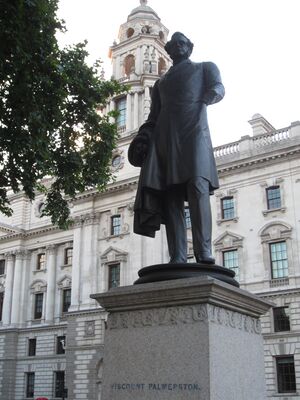
Landlords were responsible for paying the rates of every tenant whose yearly rent was £4 or less. Landlords whose land was crowded with poorer tenants were now faced with large bills. Many began clearing the poor tenants from their small plots and letting the land in larger plots for over £4 which then reduced their debts. In 1846, there had been some clearances, but the great mass of evictions came in 1847.[147] According to James S. Donnelly Jr., it is impossible to be sure how many people were evicted during the years of the famine and its immediate aftermath. It was only in 1849 that the police began to keep a count, and they recorded a total of almost 250,000 persons as officially evicted between 1849 and 1854.[148]
Donnelly considered this to be an underestimate, and if the figures were to include the number pressured into "voluntary" surrenders during the whole period (1846–1854), the figure would almost certainly exceed half a million persons.[149] While Helen Litton says there were also thousands of "voluntary" surrenders, she notes also that there was "precious little voluntary about them". In some cases, tenants were persuaded to accept a small sum of money to leave their homes, "cheated into believing the workhouse would take them in".[147]
West Clare was one of the worst areas for evictions, where landlords turned thousands of families out and demolished their derisory cabins. Captain Kennedy in April 1848 estimated that 1,000 houses, with an average of six people to each, had been levelled since November.[150] The Mahon family of Strokestown House evicted 3,000 people in 1847 and were still able to dine on lobster soup.[151]
After Clare, the worst area for evictions was County Mayo, accounting for 10% of all evictions between 1849 and 1854. George Bingham, 3rd Earl of Lucan, who owned over 60,000 acres (240 km2), was among the worst evicting landlords. He was quoted as saying that "he would not breed paupers to pay priests". Having turned out in the parish of Ballinrobe over 2,000 tenants alone, he then used the cleared land as grazing farms.[152] In 1848, the Marquis of Sligo owed £1,650 to Westport Union; he was also an evicting landlord, though he claimed to be selective, saying that he was only getting rid of the idle and dishonest. Altogether, he cleared about 25% of his tenants.[153]
In 1847, Bishop of Meath, Thomas Nulty, described his personal recollection of the evictions in a pastoral letter to his clergy:
Seven hundred human beings were driven from their homes in one day and set adrift on the world, to gratify the caprice of one who, before God and man, probably deserved less consideration than the last and least of them ... The horrid scenes I then witnessed, I must remember all my life long. The wailing of women—the screams, the terror, the consternation of children—the speechless agony of honest industrious men—wrung tears of grief from all who saw them. I saw officers and men of a large police force, who were obliged to attend on the occasion, cry like children at beholding the cruel sufferings of the very people whom they would be obliged to butcher had they offered the least resistance. The landed proprietors in a circle all around—and for many miles in every direction—warned their tenantry, with threats of their direct vengeance, against the humanity of extending to any of them the hospitality of a single night's shelter ... and in little more than three years, nearly a fourth of them lay quietly in their graves.[154]
The population in Drumbaragh, a townland in County Meath, plummeted 67 per cent between 1841 and 1851; in neighbouring Springville, it fell 54 per cent. There were fifty houses in Springville in 1841 and only eleven left in 1871.[9][10]
According to Litton, evictions might have taken place earlier but for fear of the secret societies. However, they were now greatly weakened by the Famine. Revenge still occasionally took place, with seven landlords being shot, six fatally, during the autumn and winter of 1847. Ten other occupiers of land, though without tenants, were also murdered, she says.[155]
One such landlord reprisal occurred in West Roscommon. The "notorious" Major Denis Mahon enforced thousands of his tenants into eviction before the end of 1847, with an estimated 60 per cent decline in population in some parishes. He was shot dead in that year.[156] In East Roscommon, "where conditions were more benign", the estimated decline in population was under 10 percent.[156]
Lord Clarendon, alarmed at the number of landlords being shot and that this might mean rebellion, asked for special powers. Lord John Russell was not sympathetic to this appeal. Lord Clarendon believed that the landlords themselves were mostly responsible for the tragedy in the first place, saying that "It is quite true that landlords in England would not like to be shot like hares and partridges ... but neither does any landlord in England turn out fifty persons at once and burn their houses over their heads, giving them no provision for the future." The Crime and Outrage Act was passed in December 1847 as a compromise, and additional troops were sent to Ireland.[157]
The "Gregory clause", described by Donnelly as a "vicious amendment to the Irish poor law", had been a successful Tory amendment to the Whig poor-relief bill which became law in early June 1847, where its potential as an estate-clearing device was widely recognised in parliament, although not in advance.[113] At first, the poor law commissioners and inspectors viewed the clause as a valuable instrument for a more cost-effective administration of public relief, but the drawbacks soon became apparent, even from an administrative perspective. They would soon view them as little more than murderous from a humanitarian perspective. According to Donnelly, it became obvious that the quarter-acre clause was "indirectly a death-dealing instrument".[158]
Emigration
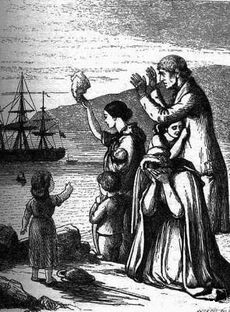
At least a million people are thought to have emigrated as a result of the famine.[7] There were about 1 million long-distance emigrants between 1846 and 1851, mainly to North America. The total given in the 1851 census is 967,908.[159] Short-distance emigrants, mainly to Britain, may have numbered 200,000 or more.[160]
While the famine was responsible for a significant increase in emigration from Ireland, of anywhere from 45% to nearly 85% depending on the year and the county, it was not the sole cause. The beginning of mass emigration from Ireland can be traced to the mid-18th century, when some 250,000 people left Ireland over a period of 50 years to settle in the New World. Irish economist Cormac Ó Gráda estimates that between 1 million and 1.5 million people emigrated during the 30 years between 1815 (when Napoleon was defeated in Waterloo) and 1845 (when the Great Famine began).[161] However, during the worst of the famine, emigration reached somewhere around 250,000 in one year alone, with western Ireland seeing the most emigrants.[162]
Families did not migrate en masse, but younger members of families did, so much so that emigration almost became a rite of passage, as evidenced by the data that show that, unlike similar emigrations throughout world history, women emigrated just as often, just as early, and in the same numbers as men. The emigrants would send remittances (reaching a total of £1,404,000 by 1851) back to family in Ireland, which, in turn, allowed another member of their family to leave.[163]
Emigration during the famine years of 1845–1850 was primarily to England, Scotland, South Wales, North America, and Australia. Many of those fleeing to the Americas used the McCorkell Line.[164] One city that experienced a particularly strong influx of Irish immigrants was Liverpool, with at least one-quarter of the city's population being Irish-born by 1851.[165] This would heavily influence the city's identity and culture in the coming years, earning it the nickname of "Ireland's second capital".[166] Liverpool became the only place outside of Ireland to elect an Irish nationalist to parliament when it elected T. P. O'Connor in 1885, and continuously re-elected him unopposed until his death in 1929.[167] As of 2020, it is estimated that three quarters of people from the city have Irish ancestry.[168]
Of the more than 100,000 Irish that sailed to Canada in 1847, an estimated one out of five died from disease and malnutrition, including over 5,000 at Grosse Isle, Quebec, an island in the Saint Lawrence River used to quarantine ships near Quebec City.[169] Overcrowded, poorly maintained, and badly provisioned vessels known as coffin ships sailed from small, unregulated harbours in the West of Ireland in contravention of British safety requirements, and mortality rates were high.[170] The 1851 census reported that more than half the inhabitants of Toronto were Irish, and, in 1847 alone, 38,000 Irish flooded a city with fewer than 20,000 citizens. Other Canadian cities such as Quebec City, Montreal, Ottawa, Kingston, Hamilton, and Saint John also received large numbers. By 1871, 55% of Saint John residents were Irish natives or children of Irish-born parents.[171] Unlike the United States, Canada could not close its ports to Irish ships because it was part of the British Empire, so emigrants could obtain cheap passage in returning empty lumber holds.
In America, most Irish became city-dwellers; with little money, many had to settle in the cities that the ships they came on landed in.[172] By 1850, the Irish made up a quarter of the population in Boston, New York City, Philadelphia, and Baltimore.
The famine marked the beginning of the depopulation of Ireland in the 19th century. The population had increased by 13–14% in the first three decades of the 19th century; between 1831 and 1841, the population grew by 5%. Application of Thomas Malthus's idea of population expanding geometrically while resources increase arithmetically was popular during the famines of 1817 and 1822. By the 1830s, they were seen as overly simplistic, and Ireland's problems were seen "less as an excess of population than as a lack of capital investment".[173] The population of Ireland was increasing no faster than that of England, which suffered no equivalent catastrophe. By 1854, between 1.5 and 2 million Irish left their country due to evictions, starvation, and harsh living conditions.[174]
Death toll
It is not known exactly how many people died during the period of the famine, although it is believed that more died from disease than from starvation.[175] State registration of births, marriages, or deaths had not yet begun, and records kept by the Catholic Church are incomplete.[fn 4] One possible estimate has been reached by comparing the expected population with the eventual numbers in the 1850s. A census taken in 1841 recorded a population of 8,175,124. A census immediately after the famine in 1851 counted 6,552,385, a drop of over 1.5 million in 10 years. The census commissioners estimated that, at the normal rate of population increase, the population in 1851 should have grown to just over 9 million if the famine had not occurred.[177]
On the in-development Great Irish Famine Online resource, produced by the Geography department of University College Cork, the population of Ireland section states, that together with the census figures being called low, before the famine it reads that "it is now generally believed" that over 8.75 million people populated the island of Ireland prior to it striking.[178]
In 1851, the census commissioners collected information on the number who died in each family since 1841, and the cause, season, and year of death. They recorded 21,770 total deaths from starvation in the previous decade and 400,720 deaths from diseases. Listed diseases were fever, diphtheria, dysentery, cholera, smallpox, and influenza, with the first two being the main killers (222,021 and 93,232). The commissioners acknowledged that their figures were incomplete and that the true number of deaths was probably higher:
The greater the amount of destitution of mortality ... the less will be the amount of recorded deaths derived through any household form;—for not only were whole families swept away by disease ... but whole villages were effaced from off the land.
Later historians agree that the 1851 death tables "were flawed and probably under-estimated the level of mortality".[179][180] The combination of institutional and figures provided by individuals gives "an incomplete and biased count" of fatalities during the famine.[181] Cormac Ó Gráda, referencing the work of W. A. MacArthur,[182] writes that specialists have long known that the Irish death tables were inaccurate,[183] and undercounted the number of deaths.[184]
S. H. Cousens's estimate of 800,000 deaths relied heavily on retrospective information contained in the 1851 census and elsewhere,[185] and is now regarded as too low.[186][48] Modern historian Joseph Lee says "at least 800,000",[187] and R. F. Foster estimates that "at least 775,000 died, mostly through disease, including cholera in the latter stages of the holocaust". He further notes that "a recent sophisticated computation estimates excess deaths from 1846 to 1851 as between 1,000,000 and 1,500,000 ... after a careful critique of this, other statisticians arrive at a figure of 1,000,000".[fn 5]
Joel Mokyr's estimates at an aggregated county level range from 1.1 million to 1.5 million deaths between 1846 and 1851. Mokyr produced two sets of data which contained an upper-bound and lower-bound estimate, which showed not much difference in regional patterns.[189][186] The true figure is likely to lie between the two extremes of half and one and a half million, and the most widely accepted estimate is one million.[190][191]
| Leinster | Munster | Ulster | Connacht | Ireland |
|---|---|---|---|---|
| 15.3 | 22.5 | 15.7 | 28.8 | 20 |
- Articles containing أيرلندية-language text
- CS1: Julian–Gregorian uncertainty
- مقالات بالمعرفة بحاجة لذكر رقم الصفحة بالمصدر from September 2018
- CS1 الإنجليزية البريطانية-language sources (en-gb)
- مقالات بالمعرفة بحاجة لذكر رقم الصفحة بالمصدر from September 2023
- CS1 الإنجليزية الأمريكية-language sources (en-us)
- Short description is different from Wikidata
- Pages using Lang-xx templates
- Articles with hatnote templates targeting a nonexistent page
- Articles with unsourced statements from November 2020
- كل المقالات بدون مراجع موثوقة
- كل المقالات بدون مراجع موثوقة from August 2020
- All articles with specifically marked weasel-worded phrases
- Articles with specifically marked weasel-worded phrases from February 2024
- Portal-inline template with redlinked portals
- Pages with empty portal template
- Great Famine (Ireland)
- Famines in Ireland
- 1840s disasters in Ireland
- 1850s disasters in Ireland
- 1845 disasters
- 1852 disasters in Europe
- 19th-century famines
- 1845 in Ireland
- 1846 in Ireland
- 1847 in Ireland
- 1848 in Ireland
- 1849 in Ireland
- 1850 in Ireland
- 1851 in Ireland
- 1852 in Ireland
- Genocides in Europe

